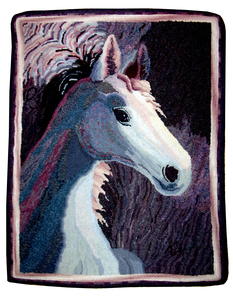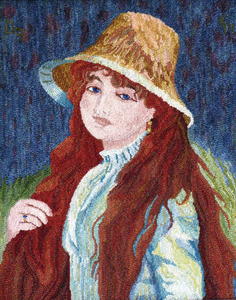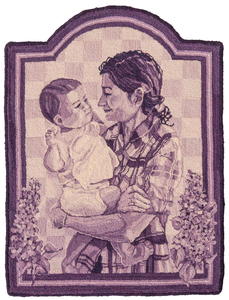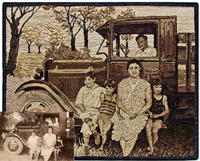Margaret Wenger: Honoring the call for color and texture
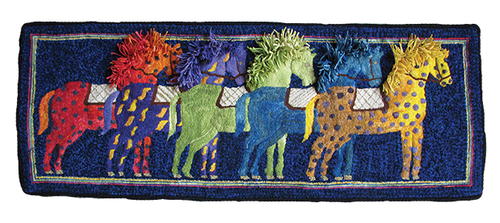
Horses of Norah, 18" x 46", #4- and 6-cut wool and gold thread on monk’s cloth. Designed and hooked by Margaret Wenger, Lancaster, Pennsylvania, 2009.
Growing up, Margaret Wenger stayed with her grandmother Helen for two weeks every summer. She admits to being “a rambunctious kid.” One day, when her grandmother’s nerves were frayed enough, she told Wenger, “‘You’re going to crochet a rug!’” Her grandmother gave her large wooden hooks and a scrap basket with various colors of threads. “I don’t care what you use,” her grandmother said, “but sit here and make a rug.” As a kid, to sit for a long period of time … “I didn’t do that very often.” Margaret says. But then she did and that’s what led her, in time, to other fiber arts, including weaving and braiding.
Years passed and Wenger, of Lancaster, Pennsylvania., was teaching a class in rug braiding at Landis Valley, a living-history museum, “when a rug hooker came in and set up her frame and laid out all her cut wool.” The hooker, Leah Fritz, was demonstrating hooking with a pictorial rug and Wenger was drawn to the colors and the strips. “I was fascinated, and that’s how I got started hooking.”
That was in 1987. Today, Wenger is a teacher who is known for using alternative materials in her hookings; “round, sparkly plastic” fishing lures that she found in a “reuse-it” shop were the strangest alternative materials ever.
Wenger cannot resist the call for color, unusual patterns in the alternative fabrics she hooks with, and textures that range from smooth to nubby. “As I get older, I have tried to do primitive.
Everyone’s definition of primitive is a little different—what it comes down to is a simple pattern with very basic color in it. And I start out that way. But it always ends up with the lion being purple and the flowers being multi-colored.”
The path here was traditional. Wenger started out with #3 and #4 cuts and fine shading. As part of her McGown certification, she needed to teach a class in 2003 and had been working on a pattern with dragonflies that she planned to use for her class. But she wanted something besides wool to capture the shimmer in the wings. “I fussed and fussed with myself to get that transparency in their wings and I found this alternative material that I felt was perfect. But I was afraid to use it and afraid I wouldn’t pass my accreditation because of using alternative material,” she says.
But, Wenger adds, Gail Dufresne encouraged her, telling her that it was her rug and she needed to do with it what she wanted. Going to Massachusetts for the class with a couple of friends, Wenger says she verged on having a panic attack. She was to teach on a Tuesday, but before that, would show the dragonflies rug to the whole group—about 200 people—so they could decide which class they would like to take.
“My class was full,” she says. “I was amazed. And I’ve been doing it ever since, using whatever material I can find that will accomplish what I want to do.”
When you think about it, she says, previous generations of rug hookers used quite a bit of old wool, but not everything they used was wool. “I’m not really doing anything that our ancestors haven’t already done. Back in the 1980s when I first started, I said to myself, ‘I will never use anything else but wool,’ and here I am, eating my words.”
Wenger generally uses about 20 percent non-wool materials in her hookings. Many years ago, she hooked a golden apple that had no wool. The background was a Halloween-themed fabric and the apple included velvet and sparkly bathing-suit material “which really set everything off.” Alternative fabrics and materials open up other avenues as they reflect, refract, and disperse light differently than wool. She entered the golden apple in a McGown rug show in New York, and though it scored no prizes, it did get people talking.
“It’s fun to see what different materials will do for you,” says Wenger. “I love working with a lot of the sparkly materials. They add just enough of the ‘wow’ factor to a rug to make it stand out.”
Read NextDolores Wiemann




